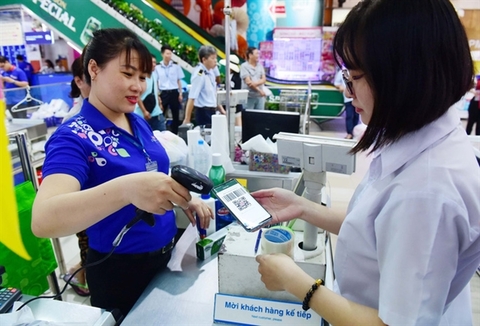
A customer makes a payment using e-wallet at a supermarket in HCM City. With more customers using e-wallets, mobile banking and web applications, banks and financial service providers need to build their cyber defences intelligently, cybersecurity company Kaspersky has warned. — Photo courtesy of nld.com.vn
HANOI — The obvious effects of the COVID-19 pandemic include the rapid increase in online payment services and digital banking across Southeast Asia.
Due to social distancing restrictions, people across the region now avoid brick-and-mortar bank branches and prefer the physically safer option of e-wallets and mobile payment applications, Yeo Siang Tiong, cybersecurity company Kaspersky’s general manager for Southeast Asia, said.
“It is, however, far beyond surprising. As early as late 2019, before COVID-19’s massive effects across SEA, I read an article which said online financial transactions in the region will be worth US$1 trillion by 2025 and the digital wallet segment will jump fivefold to $114 billion.
“I believe these two key sectors will go far beyond these predicted numbers as we try to minimize human contact for the sake of our physical health.”
A recent study by Mastercard found 40 per cent of consumers in the region saying they were using e-wallets more than ever, with Malaysia leading the way, he said.
On the other hand, cash is slowly being dethroned as king as fewer people use banknotes to buy or trade goods and services, he said.
“What makes the region a fertile land for digital banking and online payment is the fact that it has countries with a young population — millennials and Gen Z’s who are not used to physically visiting financial buildings or queuing for a long time to fill up forms with pen and paper like the generations before them did.
“Another important factor is that there is still a significant per cent of individuals who are unbanked or underbanked. This is particularly true in still emerging countries like Indonesia, Malaysia, Thailand, the Philippines, and Viet Nam.”
At the centre of this digital revolution is trust. Customers are using e-wallets, mobile banking, and web applications driven by necessity, he said.
Now, more than ever, they need to trust financial institutions to secure their money, he said.
“Digital transformation, in any sector, always presents new challenges, but especially for banks and for financial services. To put it simply, revolutionizing banks’ way of doing transactions means overhauling their legacy systems including people, process and technology.”
Humans remain the weakest link since, especially those who are not digitally native, lack proper awareness about the simplest risks like phishing and spam, while employees require new training and third-party services should be assessed comprehensively, he pointed out.
“When it comes to security, endpoint should be the foundation and banks should have known this by now. Financial services … should be looking at an adaptive approach in security which should be proactive rather than reactive – ready before an attack happens.”
The future may be foggy as different technologies continue to be developed, like AI, 5G, the Internet of Things, and cryptocurrency, but the past offers concrete lessons the financial sector could learn from, he said.
“Given the evolving nature of cyberthreats that are expected to become more sophisticated, it is also important that financial institutions have the necessary tools that help track threats that can evade regular endpoint solutions even before they hit you.
“We are in the middle of a digital revolution, and the use of online payment gateways and e-wallets are certainly here to stay and even increase. While it is a huge responsibility for banks and financial service providers to secure their virtual systems, I am certain they can pilot their way to the future as long as they build their cyber defenses intelligently.”